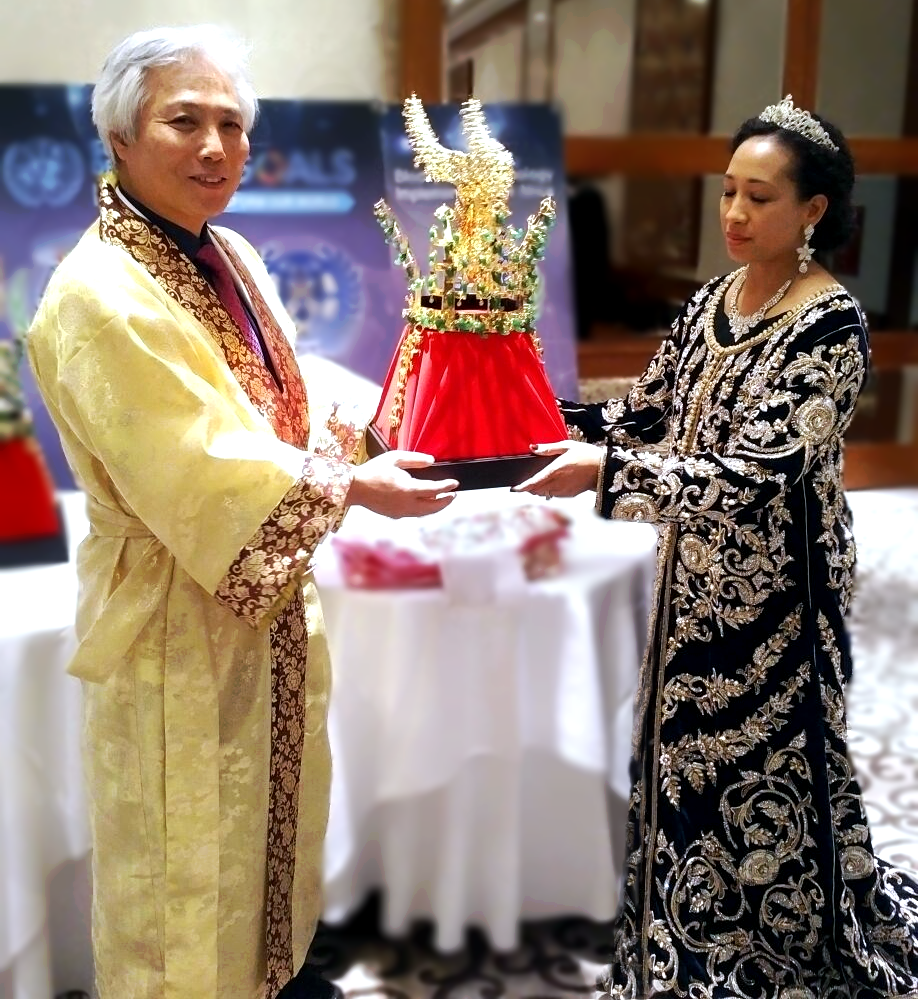IHF Head Shebah III Queen Of Sheba presented by ISEA Head with pre-coronation Far East South Throne
- The Secretariat

- Feb 26, 2018
- 3 min read

Press Release 23.09.2017 / UPDATE 28.02.2018
The House of SHEBA ancestral lines family House of DAN descendent of the last SILLA King Gyeong-ho Kim, HRH Kyeong Ju Kim presented a replica of the Royal Crown of Silla to Queen Shebah III the Queen Of Sheba.

The Founder and Chairman of ISEA the descendent crown-royal Kyeong Ju (Keonho) Kim gave a miniature symbolic replica of Crown of the Silla Dynasty to Her Imperial Majesty Queen Shebah III of related family House of SHEBA. It was presented, in honor of the ancient lines Royal House of KIM descendants to the lines Matriarch, of the Houses, in September birth-Month completion of Phase 9 of 9 of the 2000 to 2017 efforts in serve.
The real version of the Crown Of Silla was being prepared for the Queen of Sheba by the South lines for December 2017 final rites completion of 2000 to present, coronation process, however was pushed forward to the UN 56th Session 2018 ISEA Side-Event closing program as symbol presentation, to the Queen's highest attending Representative HIH Crown Princess Vanessa-Shavonne the Daughter and Eldest Child of Queen Shebah III. The Crown was later in February with the final historical signing of the MOA in close ceremony officiated as one of the Crowns of Shebah III.


Press Release 23.09.2017
The House of Sheba ancient Far East South Kingdom Golden Crown of Silla pre-coronation December 2017 replica, present to the Queen of Sheba in start of 2017 coronation completion
Silla (57 BC[note 1] – 935 AD) (Hangul: 신라; Hanja: 新羅; RR: Silla Korean pronunciation: [ɕil.la]) was a kingdom located in southern and central parts of the Korean Peninsula. It was one of the Three Kingdoms of Korea, together with Baekje and Goguryeo. Silla was also one of the world's longest sustained dynasties. Although it was founded by King Hyeokgeose, the dynasty was ruled by the Gyeongju Kim (김, 金) clan for most of its 992-year history. It began as a chiefdom in the Samhan confederacies, once allied with China, but Silla eventually conquered the other two kingdoms, Baekje in 660 and Goguryeo in 668. Thereafter, Later Silla occupied most of the Korean Peninsula, while the northern part re-emerged as Balhae, a successor-state of Goguryeo. After nearly 1000 years of rule, Silla fragmented into the brief Later Three Kingdoms of Silla, Later Baekje, and Taebong, handing over power to Goryeo in 935.[2] The final century and a half of the Silla state was one of nearly constant upheaval and civil war as the king was reduced to little more than a figurehead and powerful aristocratic families rose to actual dominance outside the capital and royal court.
The tail end of this period, called the Later Three Kingdoms period, briefly saw the emergence of the kingdoms of Later Baekje and Later Goguryeo, which were really composed of military forces capitalizing on their respective region's historic background, and Silla's submission to the Goryeo dynasty. King Gyeong-soo, the last King of Gyeongju Kin, served during the Goryeo Period system ruling Silla from Wang Geon, he emerged as an outstanding Servant Leader, in rule in time of great troubles. Kyungsun King the last King of Kim’s in Kyeong Ju in Silla Dynasty gave the position to Wang Geon, who was an excellent Servant and Leader to his people, merged with Goryeo in close of that era. The present day descendants are the House of Kim, which are a related line of Arab-African Nations House of Sheba Family lines.
South Kingdoms Family House 2017 Unification
The House of SILLA descendent of the last King Gyeong-ho Kim, Kyeong Ju Kim presented the Royal Crown of Silla to Queen Sheba III. Founder and Chairman of ISEA the descendent crown-royal Keonho Kim gave a symbolic replica of Crown of the Silla Dynasty to Her imperial Majesty Queen Shebah III of related family House of SHEBA, as in honor of the ancient lines Royal House of KIM descendants. The symbol was the precursor for the December 2017 official crown coronation ceremony presentation of and official golden jeweled version of the Crown of Silla to the Queen of the Sheba Throne shared ancestral lines South World Community, in recognition of the South Federation Queen tireless efforts.
Throughout history, The Reigning Queen Of Sheba has been honored as a Just Ruler, concerned with the well-being of Her Kingdom and its people. Today, that concern is still apparent in Her Imperial Majesty Queen Shebah III servant leadership style, putting the welfare of all the people before Her own. Her Majesty is honored to be counted with those great leaders who strive on behalf of the greatest good for their Kingdoms and Nations.










































Comments